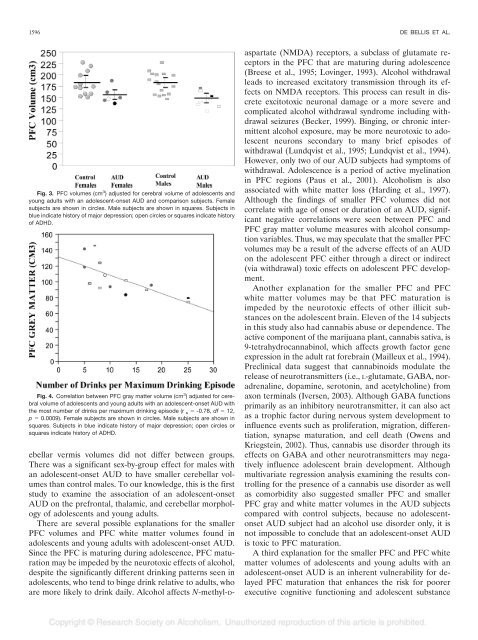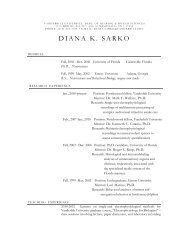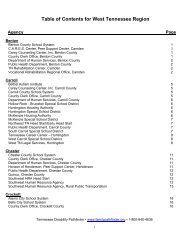Prefrontal Cortex, Thalamus, and Cerebellar Volumes in ...
Prefrontal Cortex, Thalamus, and Cerebellar Volumes in ...
Prefrontal Cortex, Thalamus, and Cerebellar Volumes in ...
You also want an ePaper? Increase the reach of your titles
YUMPU automatically turns print PDFs into web optimized ePapers that Google loves.
1596 DE BELLIS ET AL.<br />
Fig. 3. PFC volumes (cm 3 ) adjusted for cerebral volume of adolescents <strong>and</strong><br />
young adults with an adolescent-onset AUD <strong>and</strong> comparison subjects. Female<br />
subjects are shown <strong>in</strong> circles. Male subjects are shown <strong>in</strong> squares. Subjects <strong>in</strong><br />
blue <strong>in</strong>dicate history of major depression; open circles or squares <strong>in</strong>dicate history<br />
of ADHD.<br />
Fig. 4. Correlation between PFC gray matter volume (cm 3 ) adjusted for cerebral<br />
volume of adolescents <strong>and</strong> young adults with an adolescent-onset AUD with<br />
the most number of dr<strong>in</strong>ks per maximum dr<strong>in</strong>k<strong>in</strong>g episode (r s � -0.78, df � 12,<br />
p � 0.0009). Female subjects are shown <strong>in</strong> circles. Male subjects are shown <strong>in</strong><br />
squares. Subjects <strong>in</strong> blue <strong>in</strong>dicate history of major depression; open circles or<br />
squares <strong>in</strong>dicate history of ADHD.<br />
ebellar vermis volumes did not differ between groups.<br />
There was a significant sex-by-group effect for males with<br />
an adolescent-onset AUD to have smaller cerebellar volumes<br />
than control males. To our knowledge, this is the first<br />
study to exam<strong>in</strong>e the association of an adolescent-onset<br />
AUD on the prefrontal, thalamic, <strong>and</strong> cerebellar morphology<br />
of adolescents <strong>and</strong> young adults.<br />
There are several possible explanations for the smaller<br />
PFC volumes <strong>and</strong> PFC white matter volumes found <strong>in</strong><br />
adolescents <strong>and</strong> young adults with adolescent-onset AUD.<br />
S<strong>in</strong>ce the PFC is matur<strong>in</strong>g dur<strong>in</strong>g adolescence, PFC maturation<br />
may be impeded by the neurotoxic effects of alcohol,<br />
despite the significantly different dr<strong>in</strong>k<strong>in</strong>g patterns seen <strong>in</strong><br />
adolescents, who tend to b<strong>in</strong>ge dr<strong>in</strong>k relative to adults, who<br />
are more likely to dr<strong>in</strong>k daily. Alcohol affects N-methyl-D-<br />
aspartate (NMDA) receptors, a subclass of glutamate receptors<br />
<strong>in</strong> the PFC that are matur<strong>in</strong>g dur<strong>in</strong>g adolescence<br />
(Breese et al., 1995; Lov<strong>in</strong>ger, 1993). Alcohol withdrawal<br />
leads to <strong>in</strong>creased excitatory transmission through its effects<br />
on NMDA receptors. This process can result <strong>in</strong> discrete<br />
excitotoxic neuronal damage or a more severe <strong>and</strong><br />
complicated alcohol withdrawal syndrome <strong>in</strong>clud<strong>in</strong>g withdrawal<br />
seizures (Becker, 1999). B<strong>in</strong>g<strong>in</strong>g, or chronic <strong>in</strong>termittent<br />
alcohol exposure, may be more neurotoxic to adolescent<br />
neurons secondary to many brief episodes of<br />
withdrawal (Lundqvist et al., 1995; Lundqvist et al., 1994).<br />
However, only two of our AUD subjects had symptoms of<br />
withdrawal. Adolescence is a period of active myel<strong>in</strong>ation<br />
<strong>in</strong> PFC regions (Paus et al., 2001). Alcoholism is also<br />
associated with white matter loss (Hard<strong>in</strong>g et al., 1997).<br />
Although the f<strong>in</strong>d<strong>in</strong>gs of smaller PFC volumes did not<br />
correlate with age of onset or duration of an AUD, significant<br />
negative correlations were seen between PFC <strong>and</strong><br />
PFC gray matter volume measures with alcohol consumption<br />
variables. Thus, we may speculate that the smaller PFC<br />
volumes may be a result of the adverse effects of an AUD<br />
on the adolescent PFC either through a direct or <strong>in</strong>direct<br />
(via withdrawal) toxic effects on adolescent PFC development.<br />
Another explanation for the smaller PFC <strong>and</strong> PFC<br />
white matter volumes may be that PFC maturation is<br />
impeded by the neurotoxic effects of other illicit substances<br />
on the adolescent bra<strong>in</strong>. Eleven of the 14 subjects<br />
<strong>in</strong> this study also had cannabis abuse or dependence. The<br />
active component of the marijuana plant, cannabis sativa, is<br />
9-tetrahydrocannab<strong>in</strong>ol, which affects growth factor gene<br />
expression <strong>in</strong> the adult rat forebra<strong>in</strong> (Mailleux et al., 1994).<br />
Precl<strong>in</strong>ical data suggest that cannab<strong>in</strong>oids modulate the<br />
release of neurotransmitters (i.e., L-glutamate, GABA, noradrenal<strong>in</strong>e,<br />
dopam<strong>in</strong>e, seroton<strong>in</strong>, <strong>and</strong> acetylchol<strong>in</strong>e) from<br />
axon term<strong>in</strong>als (Iversen, 2003). Although GABA functions<br />
primarily as an <strong>in</strong>hibitory neurotransmitter, it can also act<br />
as a trophic factor dur<strong>in</strong>g nervous system development to<br />
<strong>in</strong>fluence events such as proliferation, migration, differentiation,<br />
synapse maturation, <strong>and</strong> cell death (Owens <strong>and</strong><br />
Kriegste<strong>in</strong>, 2002). Thus, cannabis use disorder through its<br />
effects on GABA <strong>and</strong> other neurotransmitters may negatively<br />
<strong>in</strong>fluence adolescent bra<strong>in</strong> development. Although<br />
multivariate regression analysis exam<strong>in</strong><strong>in</strong>g the results controll<strong>in</strong>g<br />
for the presence of a cannabis use disorder as well<br />
as comorbidity also suggested smaller PFC <strong>and</strong> smaller<br />
PFC gray <strong>and</strong> white matter volumes <strong>in</strong> the AUD subjects<br />
compared with control subjects, because no adolescentonset<br />
AUD subject had an alcohol use disorder only, it is<br />
not impossible to conclude that an adolescent-onset AUD<br />
is toxic to PFC maturation.<br />
A third explanation for the smaller PFC <strong>and</strong> PFC white<br />
matter volumes of adolescents <strong>and</strong> young adults with an<br />
adolescent-onset AUD is an <strong>in</strong>herent vulnerability for delayed<br />
PFC maturation that enhances the risk for poorer<br />
executive cognitive function<strong>in</strong>g <strong>and</strong> adolescent substance







